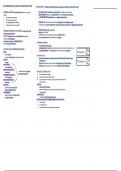Samenvatting
Summary Option D: Medicinal Chemistry (IB Chemistry)
These notes encompass all of the information necessary for a student studying Option D of IB Chemistry. Every topic from D.1 - D.9 is included in these notes with detail on every aspect.
[Meer zien]




